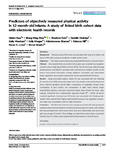Predictors of objectively measured physical activity in 12‐month‐old infants: A study of linked birth cohort data with electronic health records
| dc.contributor.author | Raza, H | |
| dc.contributor.author | Zhou, Shang-Ming | |
| dc.contributor.author | Todd, C | |
| dc.contributor.author | Christian, D | |
| dc.contributor.author | Marchant, E | |
| dc.contributor.author | Morgan, K | |
| dc.contributor.author | Khanom, A | |
| dc.contributor.author | Hill, R | |
| dc.contributor.author | Lyons, RA | |
| dc.contributor.author | Brophy, S | |
| dc.date.accessioned | 2021-02-04T22:23:34Z | |
| dc.date.issued | 2019-07 | |
| dc.identifier.issn | 2047-6302 | |
| dc.identifier.issn | 2047-6310 | |
| dc.identifier.other | ARTN e12512 | |
| dc.identifier.uri | http://hdl.handle.net/10026.1/16856 | |
| dc.description.abstract |
<jats:title>Summary</jats:title><jats:sec><jats:title>Background</jats:title><jats:p>Physical activity (PA) levels are associated with long‐term health, and levels of PA when young are predictive of adult activity levels.</jats:p></jats:sec><jats:sec><jats:title>Objectives</jats:title><jats:p>This study examines factors associated with PA levels in 12‐month infants.</jats:p></jats:sec><jats:sec><jats:title>Method</jats:title><jats:p>One hundred forty‐one mother‐infant pairs were recruited via a longitudinal birth cohort study (April 2010 to March 2013). The PA level was collected using accelerometers and linked to postnatal notes and electronic medical records via the Secure Anonymised Information Linkage databank. Univariable and multivariable linear regressions were used to examine the factors associated with PA levels.</jats:p></jats:sec><jats:sec><jats:title>Results</jats:title><jats:p>Using univariable analysis, higher PA was associated with the following (<jats:italic>P</jats:italic> value less than 0.05): being male, larger infant size, healthy maternal blood pressure levels, full‐term gestation period, higher consumption of vegetables (infant), lower consumption of juice (infant), low consumption of adult crisps (infant), longer breastfeeding duration, and more movement during sleep (infant) but fewer night wakings. Combined into a multivariable regression model (<jats:italic>R</jats:italic><jats:sup>2</jats:sup> = 0.654), all factors remained significant, showing lower PA levels were associated with female gender, smaller infant, preterm birth, higher maternal blood pressure, low vegetable consumption, high crisp consumption, and less night movement.</jats:p></jats:sec><jats:sec><jats:title>Conclusion</jats:title><jats:p>The PA levels of infants were strongly associated with both gestational and postnatal environmental factors. Healthy behaviours appear to cluster, and a healthy diet was associated with a more active infant. Boys were substantially more active than girls, even at age 12 months. These findings can help inform interventions to promote healthier lives for infants and to understand the determinants of their PA levels.</jats:p></jats:sec> | |
| dc.format.extent | e12512-e12512 | |
| dc.format.medium | Print-Electronic | |
| dc.language | en | |
| dc.language.iso | en | |
| dc.publisher | Wiley | |
| dc.subject | gestation | |
| dc.subject | infants | |
| dc.subject | physical activity | |
| dc.subject | postnatal development | |
| dc.title | Predictors of objectively measured physical activity in 12‐month‐old infants: A study of linked birth cohort data with electronic health records | |
| dc.type | journal-article | |
| dc.type | Journal Article | |
| dc.type | Research Support, Non-U.S. Gov't | |
| plymouth.author-url | https://www.webofscience.com/api/gateway?GWVersion=2&SrcApp=PARTNER_APP&SrcAuth=LinksAMR&KeyUT=WOS:000470005100001&DestLinkType=FullRecord&DestApp=ALL_WOS&UsrCustomerID=11bb513d99f797142bcfeffcc58ea008 | |
| plymouth.issue | 7 | |
| plymouth.volume | 14 | |
| plymouth.publisher-url | https://onlinelibrary.wiley.com/doi/full/10.1111/ijpo.12512 | |
| plymouth.publication-status | Published | |
| plymouth.journal | Pediatric Obesity | |
| dc.identifier.doi | 10.1111/ijpo.12512 | |
| plymouth.organisational-group | /Plymouth | |
| plymouth.organisational-group | /Plymouth/Faculty of Health | |
| plymouth.organisational-group | /Plymouth/Faculty of Health/School of Nursing and Midwifery | |
| plymouth.organisational-group | /Plymouth/REF 2021 Researchers by UoA | |
| plymouth.organisational-group | /Plymouth/REF 2021 Researchers by UoA/UoA03 Allied Health Professions, Dentistry, Nursing and Pharmacy | |
| plymouth.organisational-group | /Plymouth/Users by role | |
| plymouth.organisational-group | /Plymouth/Users by role/Academics | |
| dc.publisher.place | England | |
| dcterms.dateAccepted | 2019-01-05 | |
| dc.rights.embargodate | 2021-2-6 | |
| dc.identifier.eissn | 2047-6310 | |
| dc.rights.embargoperiod | Not known | |
| rioxxterms.funder | Medical Research Council | |
| rioxxterms.identifier.project | DECIPHer: Centre for the Development and Evaluation of Complex Interventions for Public Health Improvement | |
| rioxxterms.versionofrecord | 10.1111/ijpo.12512 | |
| rioxxterms.licenseref.uri | http://www.rioxx.net/licenses/all-rights-reserved | |
| rioxxterms.licenseref.startdate | 2019-07 | |
| rioxxterms.type | Journal Article/Review | |
| plymouth.funder | DECIPHer: Centre for the Development and Evaluation of Complex Interventions for Public Health Improvement::Medical Research Council |


